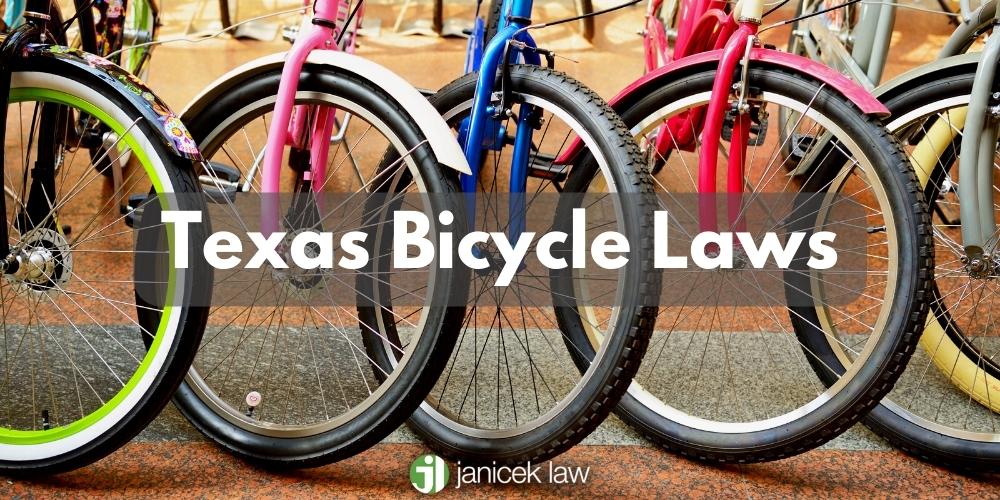In a large and busy city like San Antonio, Texas, bicycles are becoming a very popular mode of transportation not only for the sake of exercise, but also because traveling via bicycle can be faster than traveling via car, especially when there’s constant bumper-to-bumper traffic. In order for everyone to safely travel in busy cities, the Texas Transportation Code has laid strict rules for persons operating bicycles. Violating these rules can result in catastrophic injuries, death, and financial loss. If you’re a person operating a bicycle or electric bicycle, it’s important to familiarize yourself with these rules to not only protect your safety, but to protect yourself from liability as well.
If you or a loved one has suffered serious injuries, wrongful death, or financial loss from a bicycle accident in Texas, it’s crucial to arm yourself with the strongest possible legal representation. Call our San Antonio bicycle accident lawyers at 210-366-4949 today.
Bicycle Accident Statistics in the U.S.
The National Highway Traffic Safety Administration states that there were 938 bicyclist deaths from motor vehicle collisions in 2020, marking a 9% increase in deaths compared to the previous year. The bicycle-related fatalities in 2020 constituted 2% of the total motor vehicle death count in the United States.
In the same year, a report from the Consumer Product Safety Commission highlighted that bicycles were associated with 425,910 emergency room visits, encompassing both avoidable and deliberate injuries.
Annually, the financial toll of these tragedies typically surpasses $20 million in the U.S., as stated in a 2019 NHTSA report.
How Many Bicycle Accidents Happen in San Antonio, Texas?
Unfortunately, San Antonio can be a very dangerous city for people to ride bikes. 62 Texan bicyclists lost their lives due to car accidents in 2016, with 5 of these deaths occurring in San Antonio. These bicycle accident deaths represent a 25% increase in deaths compared to the year before.
Even though San Antonio has made efforts to improve cycling infrastructure, such as expanding sidewalks with a designated bicycle lane, it continues to rank low on the scale of bicycle-friendly cities. 2021 research by Arris Composites evaluated the bike-friendliness of cities, and the findings depicted Texas as generally not conducive for cyclists, placing San Antonio and Fort Worth at the tail end within the state. This evaluation considered factors like climate, bicycle mishaps, and infrastructure development.
Common Types of Bicycle Injuries
Bicyclists involved in accidents typically suffer catastrophic injuries due to the lack of protection they have compared to drivers in motor vehicles. Some cyclists don’t even protect themselves with helmets or elbow and knee pads. Common bicycle accident injuries can include:
- Back and neck injuries
- Broken bones
- Broken or missing teeth
- Facial scarring and disfigurement
- Internal organ damage
- Joint injuries
- Nerve damage
- Partial or complete paralysis
- Permanent eye damage
- Road rash
- Spinal cord injuries
- Torn ligaments
- Traumatic brain injuries (TBI)
- Wrongful death
- And more
If you’ve suffered major injuries in a bicycle accident, reaching out to a San Antonio bicycle accident lawyer at Janicek Law is crucial to ensure you obtain justice and fair compensation.
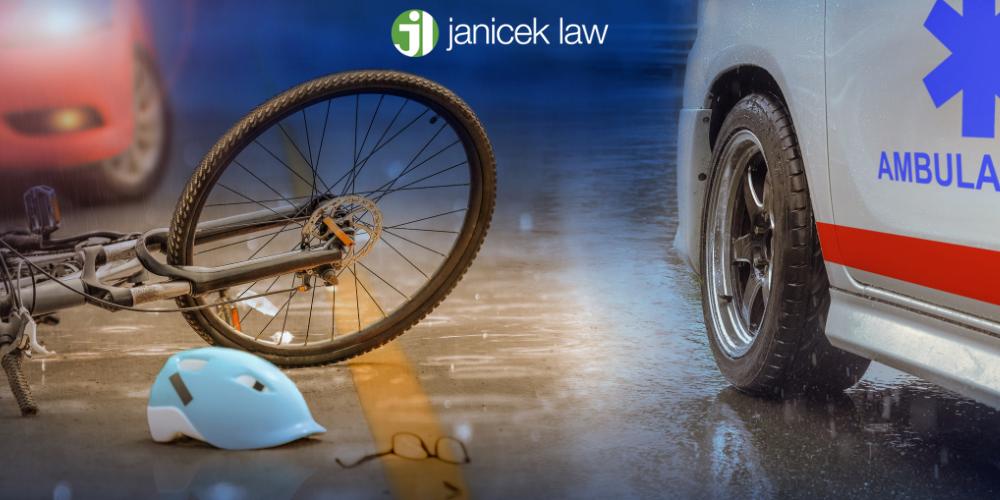
Texas Bicycle Laws
Cycling is not just a hobby or a mode of transportation; it’s a way of life for many Texans. With the increasing number of cyclists on the road, it’s paramount to be well-informed about Texas bicycle laws to ensure everyone is safely riding alongside motor vehicles. The Texas Transportation Code outlines several rules regarding the safe operation of bicycles. Failure to follow these rules can lead to a Class C misdemeanor and fines of up to $200.
General Operation of a Bicycle
In Texas, bicycles are considered vehicles just like other motor vehicles, meaning cyclists have the same rights and responsibilities as other motorists. This encompasses obeying all traffic laws, signals, signs, and lane markings. Just like drivers, bicycle operators are expected to ride with caution, being considerate of pedestrians and other vehicles on a laned roadway.
A person operating a bicycle, electric bicycle, coaster, sled, toy vehicle, or roller skates cannot attach either the person or one of the aforementioned vehicles to another vehicle on the road. Additionally, a person operating a bicycle cannot ride anywhere except for a permanent and regular seat attached to the bicycle. For example, a person cannot sit in a bicycle basket while someone else is pedaling the bike. People who violate these general operation rules can suffer serious injuries and even death, especially in a busy city like San Antonio, TX.
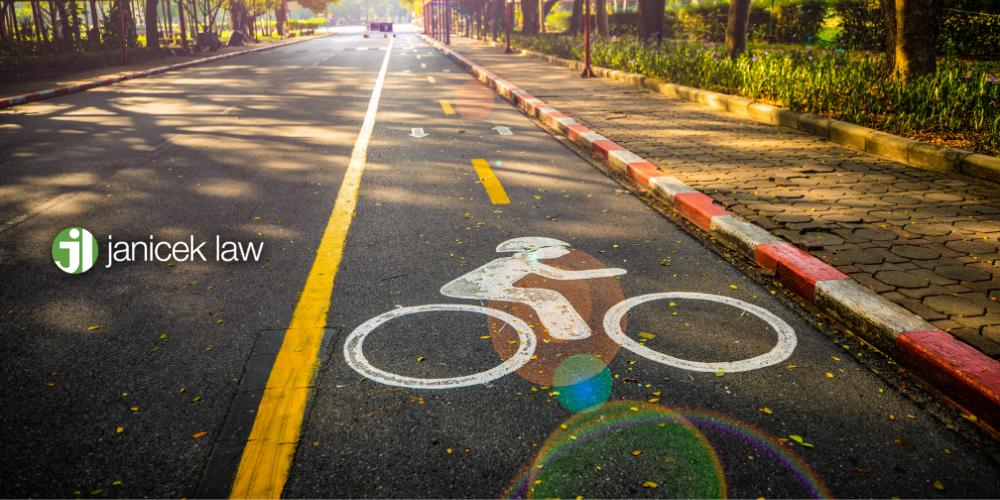
Bicycle Operation on a Roadway
When cycling on a roadway, it’s crucial to ride as close as possible to the right curb or edge of the roadway as possible. Or if there is a designated bicycle lane adjacent to a single lane, the cyclist should ride in that lane. If a cyclist is on a one way street, they can ride near the left curb instead of the right curb or edge of the road. Exceptions to this rule apply when passing another vehicle moving in the same direction, preparing for a left turn at an intersection or onto a private road, or when avoiding poor road conditions or a fixed or moving object on the road.
A person operating a bicycle may overtake the lane if another pedestrian or cyclist going the same direction is moving slower than they are. Additionally, persons operating bicycles on a road can ride abreast as long as they stay in a single lane. Persons riding two abreast can’t interfere with the normal and reasonable flow of traffic on the road.
Where to Ride Bicycles
Typically, cyclists are urged to use a designated bicycle lane adjacent to marked traffic lanes when they’re available. However, if there is no lane set aside for the exclusive operation of bicycles, then cyclists should use the road and adhere to the same rules that motorists follow (riding in the right lane, near the right curb or edge of the road). Riding on sidewalks is discouraged in most areas, especially busy cities, as it can lead to pedestrian accidents.
Bicycle Safety Equipment
Safety should always come first when cycling. Texas bicycle laws mandate that bikes ridden at night must be equipped with a front white light visible from a distance of 500 feet ahead and a rear red lamp at the rear of the bicycle that’s visible from a distance of 500 feet. These lights or reflectors should be visible when the light from motor vehicle headlamps hits them. Proper reflective gear and helmets, though not mandated for adults, are highly recommended.
Additionally, cyclists should have a brake capable of creating a braked wheel skid on dry pavement so that they can stop as safely as quickly as possible if need be. Texas law does not mandate that all cyclists wear helmets while riding, although this is highly recommended because bicycles provide absolutely no protection against other motor vehicles in the event of an accident.
Handlebar Laws
Texas bicycle laws state that cyclists must keep at least one hand on the handlebars at all times in order to maintain control and safety on the roads.
Cycling Under the Influence of Alcohol or Drugs
In Texas, a person may not operate any motor vehicle while under the influence of drugs or alcohol. These laws don’t specifically mention bicyclists, but since bicycles are considered a type of motor vehicle, a person operating a bicycle should do so sober as well.
Alcohol and drugs impair judgment, reflexes, and the ability to operate any motor vehicle safely, including a bicycle. Cyclists found to be under the influence may face similar consequences as drivers, including fines or even arrest, especially if they cause an accident due to their intoxication.
Giving Arm and Hand Signals
Communication is key for safety on the road. Since bicycles don’t have turn signals like cars do, it’s important for cyclists to provide a hand and arm signal before turning, especially on a very busy road.
Persons operating bicycles should extend the left hand and arm horizontally if they’re making a left turn. Those who are making a right turn should extend the left hand and arm upward. If the cyclist is on the right hand side of the roadway already and they plan to make a right turn, they can also have their right arm extended horizontally to the right side. If the cyclist is stopping or decreasing speed, they should extend their hand and arm downward.
These signals should be given continuously for at least 100 feet before taking action, ensuring other road users are well-informed of your intentions.
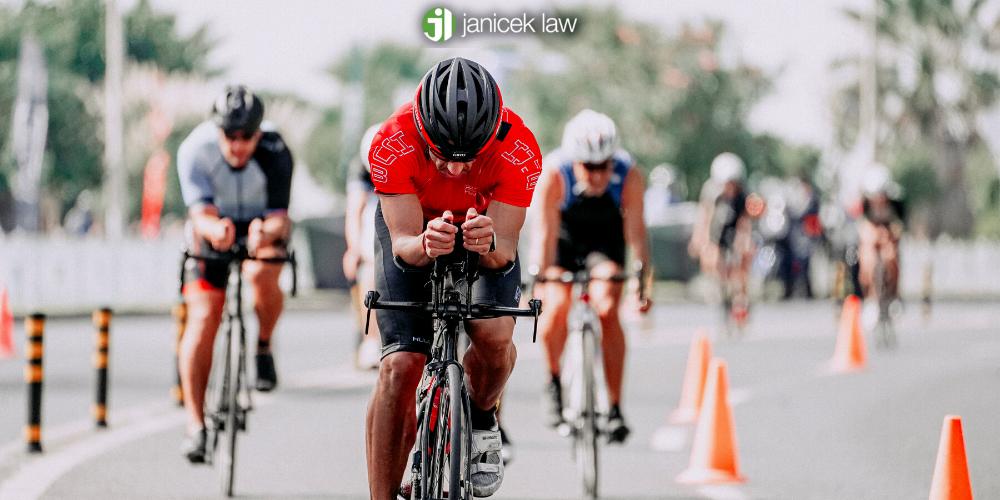
Competitive Racing
Competitive bicycle racing is a thrilling sport but comes with its set of regulations. Before engaging in a competitive bicycle race on public roads, appropriate permits must be obtained from local law enforcement agencies. Additionally, participants should adhere to specific safety guidelines and rules outlined by the event organizers, ensuring the safety of racers, spectators, and other road users.
San Antonio, TX Bicycle Ordinances
The city of San Antonio has its own set of safety regulations governing bicyclists that should be followed on top of state rules.
- Bike Light Ordinance: In San Antonio, every bicycle must be equipped with a front-facing white light and a rear-facing red lamp visible from a distance of at least 500 feet. Non-compliance can lead to a $200 penalty and a Class C Misdemeanor charge. As previously stated, a similar state-wide law already exists in Texas.
- Safe Passing Ordinance: This rule mandates a safe overtaking distance for vulnerable road users. Vehicles should maintain a 3-foot gap, and for larger trucks or commercial vehicles, the distance should be 6 feet, provided the road conditions permit. Violation of this rule can result in a $200 fine and a Class C Misdemeanor.
- Ordinances Sec. 19-286: Cycling on sidewalks in San Antonio is prohibited, with exceptions for law enforcement or emergency services personnel.
When to File A Bicycle Accident Report in Texas
If you’re involved in a bicycle accident, it’s crucial to contact local law enforcement and medical professionals immediately. You should also file a bicycle accident report if there’s injury, death, or property damage exceeding $1,000, or if a vehicle is damaged to the point where it is no longer drivable.
Even if you think the accident is minor and doesn’t require the involvement of law enforcement, it’s important to file a report for insurance and legal purposes anyway.
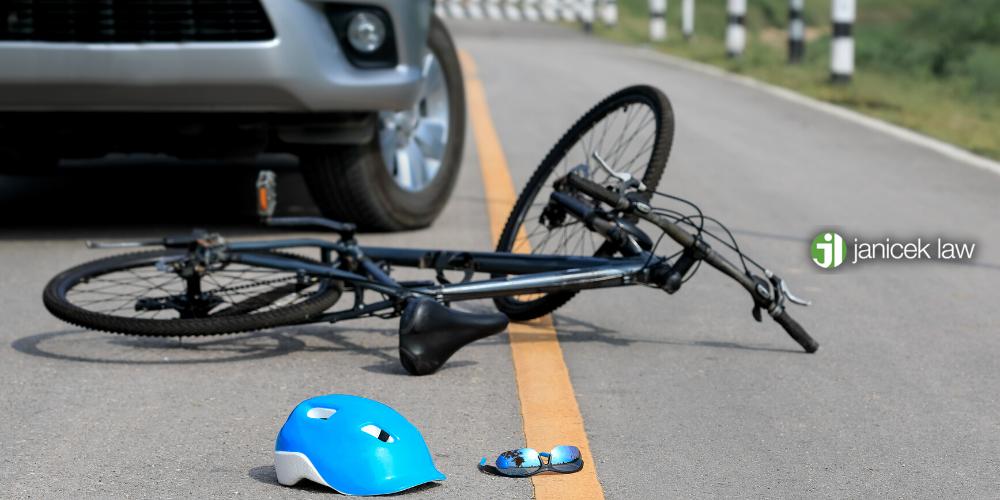
Proving Fault in a Bicycle Accident
Determining who’s at fault in a bicycle accident can be difficult depending on the specifics of a situation. Evidence such as witness testimonies, police reports, and surveillance footage can play a pivotal role in establishing fault in an accident. Both the cyclist and the driver operating a vehicle have a duty of care to ride safely, and a breach of this duty may be considered negligence for one or both parties.
In major bicycle accidents that result in severe injury, death, or property damage, it’s crucial to hire an experienced personal injury attorney at Janicek Law. We can help accurately determine the percentage of fault for both parties, which will then help calculate the amount of damages each party is entitled to based on comparative negligence laws in Texas.
Bicycle Accident Damages
After an accident, victims can claim two main types of damages: economic damages and non-economic damages.
Economic Damages
Economic damages include losses that had a tangible cost, such as:
- Medical bills;
- Rehabilitative bills;
- Expenses associated with necessary medical equipment;
- Caregiving expenses (if the cyclist is permanently injured or disabled);
- Lost wages;
- Loss of earning capacity;
- Property damage;
- And/or funeral and burial expenses if the accident resulted in wrongful death.
Non-Economic Damages
Non-economic damages include intangible losses, such as:
- Physical pain and suffering;
- Emotional distress;
- Permanent scarring, disfigurement, or disability;
- Loss of enjoyment of life;
- And/or loss of consortium.
Calculating both economic and non-economic damages can be complex, which is why it’s so important to hire the experienced bicycle accident lawyers at Janicek Law. We will carefully calculate the damages you suffered so that you receive a fair settlement.
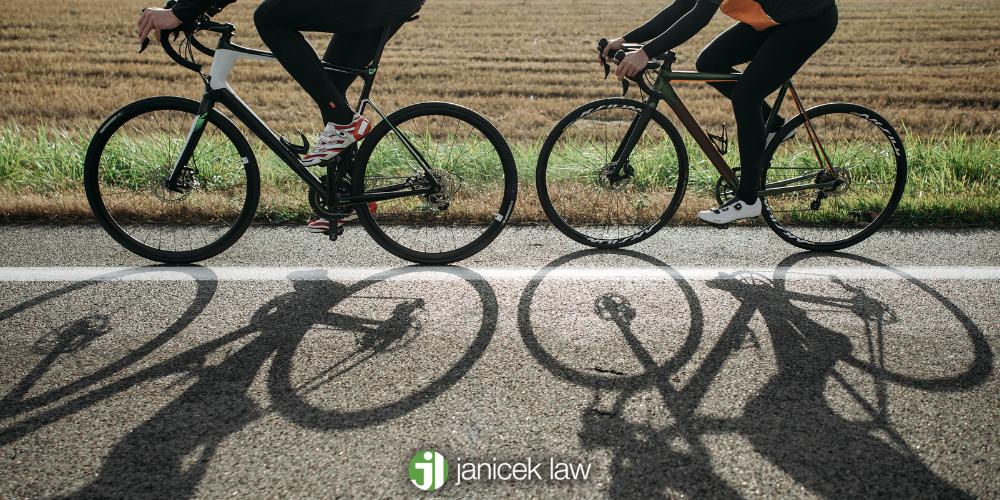
Call San Antonio Bicycle Accident Lawyers at Janicek Law Today
If you or a loved one has been involved in a Texas bicycle accident, you don’t have to face the aftermath alone. The experienced personal injury team at Janicek Law can provide the guidance and representation you need to navigate the complexities of Texas bicycle laws, ensuring that you get the justice and compensation you deserve. Don’t wait; reach out to Janicek Law today at 210-366-4949 and allow us to protect your legal rights and fight for your justice.

